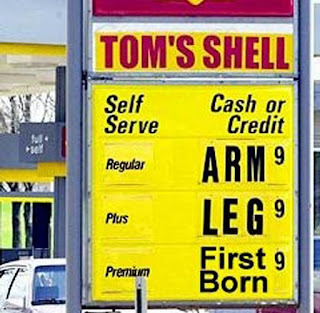The Rising Price of Gasoline
The decision I made several years ago to buy a 15 mile/gallon gas guzzling Ford Explorer is really coming back to bite me in the ass. This week the national average price for a gallon of gasoline has risen above $3.50 per gallon for only the third time in history. Even more disturbing is that the normal highs for gasoline are achieved in the spring and summer months. There is logical reasoning behind this trend. Less expensive blends of gasoline are sold in the winter. Pricier, cleaner blends are sold in the summer months. This is troubling news for an economy that could do without the burden of high energy costs. Unfortunately, the rising price of gasoline reinforces the struggles our economy will face this summer.The Morning Call, A Lehigh Valley Pennsylvania Newspaper, has an article detailing the current rise in gas prices and forecasts hefty price increases this summer due to several contributing factors. In an interview with Tom Kloza the MC points out that this year's winter to spring transition could be worse due to issues with refineries.
"Early February crude oil prices are higher than they've ever been on similar calendar dates through the years, and the price of crude sets the standard for gasoline prices," Kloza said, later adding, "We've lost a number of refineries in the last six months (to permanent closure). Some of those refineries represented the key to a smooth spring transition from winter-to-spring gasoline."
The issues with refineries are echoed in an article this week in the San Francisco Chronicle.
Three Pennsylvania oil refineries, struggling with low profit margins, could shut down if their owners don't find buyers. In the Virgin Islands, a refinery that ships gasoline to the East Coast will close this month. So will another in Germany. Together, the closures will squeeze gasoline supplies in the eastern United States.
Fewer refineries will decrease the supply of gasoline available for consumption. Obviously, demand will increase during the spring and summer months as people emerge from their winter hibernations and start to navigate the nation's roads. The increase in demand results in a price increase with outside forces being equal. Unfortunately, there are many other factors, in addition to closing refineries and seasonal market conditions, driving the cost of oil.On top of the economic problems forcing oil refineries out of business, which I plan to address in a future post, the global oil market could potentially be impacted instability in the Middle East. If Iran closes the Straits of Hormuz the economic impact would be devastating to the global economy. Unfortunately, this outcome seems more likely to occur with each passing day due to the United States' arrogantly placing sanctions on Iran's Central Bank. The United States intervening in the affairs of the Iranian people is not a new policy. In fact, as Michael Rozeff explains, it has been common place for decades. The United State has not been deterred by the Algiers Accords signed by the U.S. and Iran in 1981. In the Algiers Accords the U.S. promised not to directly or indirectly, politically or militarily intervene in Iran's affairs. It is important to note, that the likelihood of war decreases significantly when foreign policy is rooted in free trade between countries as opposed to one nation initiating the use of government force to influence the internal affairs of another nation.There is an often ignored factor that likely will exert upward pressure on gasoline prices here in the United States this summer, devalued dollars. Market prognosticators become enamored with the variables that influence supply or demand of a commodity, in this case oil. Frequently, they neglect to factor in the value of the commodity that is being used to execute the transaction, fiat money. We've talked about the Fed a great deal on this blog, but it's almost impossible to write about the state of the economy while neglecting to define the Federal Reserves’ role. The majority of the dollars that have been printed over the past 5 years are still sitting on the sidelines, strengthening the balance sheets of investment banks. As more newly created dollars are circulated and begin to flood the market place the purchasing power of the dollar will continue to decrease. This phenomenon will result in the appearance that goods and services are becoming more expensive based on supply and demand of the good or service. In reality, the goods or services changed minimally in value. The shift in price was caused by the devaluation of the money being used in the transaction. Based on a decreasing refinery output and any potential instability of the supply of oil from Middle Eastern countries the U.S. is likely to see $5/gallon gasoline this summer. Combine those issues with the purchasing power of the dollar's continued decline and we could see the price of gasoline easily surpass $5/gallon. It might be a good idea to make some plans this summer that involve minimal travel or utilize types of transportation that are not affected by rising oil prices. Maybe try riding a bike!


